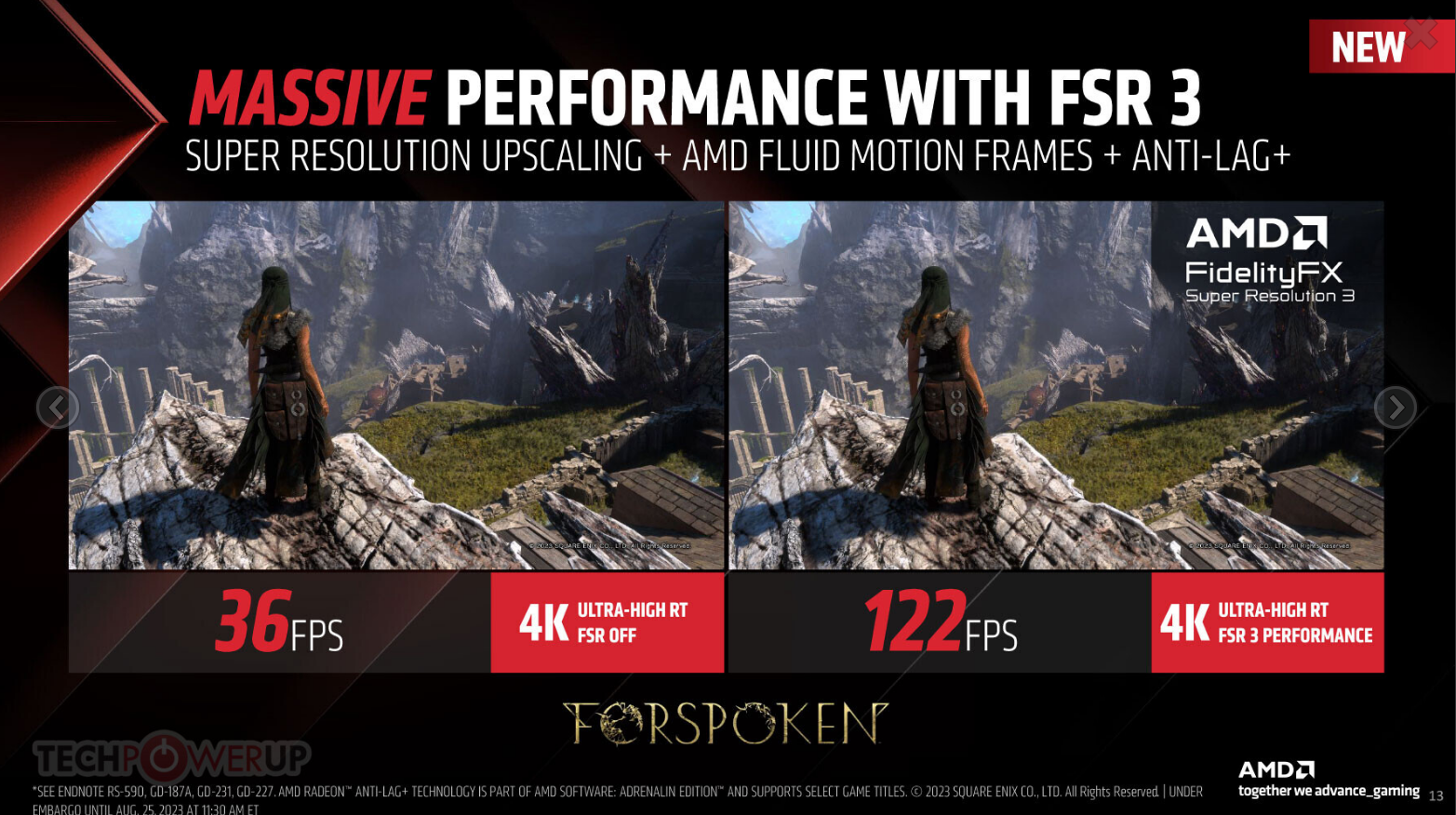Creating a separate thread for this particular Frame Generation tech as this is different from FSR 3
https://www.eurogamer.net/digitalfo...-3-tech-and-frame-gen-for-every-dx11dx12-game
This is using optical flow only. No motion vector input from FSR 2 means that the best AFMF can do is interpolate a new frame between two standard rendered frames similar to the way a TV does it - albeit with far less latency. The generated frames will be 'coarser' without the motion vector data but the effectiveness of those frames will scale according to content and the base frame-rate. A slower moving game, for example, makes it easier to interpolate content as there is less difference between the two standard rendered frames. Meanwhile, the higher the base frame-rate, the less time a generated frame persists on-screen - with the lower quality interpolated frames 'strobing' between standard rendered frames. Typically, all frame-gen solutions benefit from higher base frame-rates, but this is especially important with AMFS.
AFMF is intended to be run on games that are already able to hit a smooth frame-rate (70fps, for instance), with the goal of maxing out a 120Hz or 144Hz panel, with higher frame-rates resulting in higher image quality, for the reasons previously stated. Similar to the Radeon Boost driver-level dynamic resolution scaling feature, the tech is automatically disabled in response to rapid mouse movement, presumably to prevent obvious visual anomalies that will occur in frame generation when the two source frames have so little in common.
it's another feature available to gamers that'll find utility on high refresh rate screens, which are basically the norm in the PC market these days. AMD is perfectly clear about the strengths and weaknesses of AFMF and at the very least, RDNA 3 users will have a fascinating new tool to experiment with. At best, you have an 'after-market' frame generation solution that could work really well on a huge number of games. Then there's the Asus ROG Ally - a handheld with RDNA 3 graphics and a 120Hz VRR screen, where the artefacts could well be far less noticeable.
https://www.eurogamer.net/digitalfo...-3-tech-and-frame-gen-for-every-dx11dx12-game
This is using optical flow only. No motion vector input from FSR 2 means that the best AFMF can do is interpolate a new frame between two standard rendered frames similar to the way a TV does it - albeit with far less latency. The generated frames will be 'coarser' without the motion vector data but the effectiveness of those frames will scale according to content and the base frame-rate. A slower moving game, for example, makes it easier to interpolate content as there is less difference between the two standard rendered frames. Meanwhile, the higher the base frame-rate, the less time a generated frame persists on-screen - with the lower quality interpolated frames 'strobing' between standard rendered frames. Typically, all frame-gen solutions benefit from higher base frame-rates, but this is especially important with AMFS.
AFMF is intended to be run on games that are already able to hit a smooth frame-rate (70fps, for instance), with the goal of maxing out a 120Hz or 144Hz panel, with higher frame-rates resulting in higher image quality, for the reasons previously stated. Similar to the Radeon Boost driver-level dynamic resolution scaling feature, the tech is automatically disabled in response to rapid mouse movement, presumably to prevent obvious visual anomalies that will occur in frame generation when the two source frames have so little in common.
it's another feature available to gamers that'll find utility on high refresh rate screens, which are basically the norm in the PC market these days. AMD is perfectly clear about the strengths and weaknesses of AFMF and at the very least, RDNA 3 users will have a fascinating new tool to experiment with. At best, you have an 'after-market' frame generation solution that could work really well on a huge number of games. Then there's the Asus ROG Ally - a handheld with RDNA 3 graphics and a 120Hz VRR screen, where the artefacts could well be far less noticeable.
Ooo
“In addition to the Radeon RX 7800 XT and RX 7700 XT graphics cards, AMD announced FidelityFX Super Resolution 3 Fluid Motion (FSR 3 Fluid Motion), the company's performance enhancement that's designed to rival NVIDIA DLSS 3 Frame Generation. The biggest piece of news here, is that unlike DLSS 3, which is restricted to GeForce RTX 40-series "Ada," FSR 3 enjoys the same kind of cross-brand hardware support as FSR 2. It works on the latest Radeon RX 7000 series, as well as previous-generation RX 6000 series RDNA2 graphics cards, as well as NVIDIA GeForce RTX 40-series, RTX 30-series, and RTX 20-series. It might even be possible to use FSR 3 with Arc A-series, although AMD wouldn't confirm it.
FSR 3 Fluid Motion is a frame-rate doubling technology that generates alternate frames by estimating an intermediate between two frames rendered by the GPU (which is essentially what DLSS 3 is). The company did not detail the underlying technology behind FSR 3 in its pre-briefing, but showed an example of FSR 3 implemented on "Forspoken," where the game puts out 36 FPS at 4K native resolution, is able to run at 122 FPS with FSR 3 "performance" preset (upscaling + Fluid Motion + Anti-Lag). At 1440p native, with ultra-high RT, "Forspoken" puts out 64 FPS, which nearly doubles to 106 FPS without upscaling (native resolution) + Fluid Motion frames + Anti-Lag. The Maximum Fidelity preset of FSR 3 is essentially AMD's version of DLAA (to use the detail regeneration and AA features of FSR without dropping down resolution).”
https://www.techpowerup.com/312786/...motion-rivaling-dlss-3-broad-hardware-support
![[H]ard|Forum](/styles/hardforum/xenforo/logo_dark.png)
